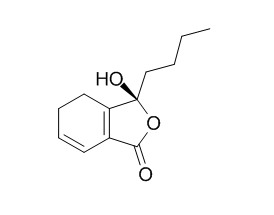Senkyunolide G
Senkyunolide G and senkyunolide I could serve as pharmacokinetic markers for sepsis care.
Inquire / Order:
manager@chemfaces.com
Technical Inquiries:
service@chemfaces.com
Tel:
+86-27-84237783
Fax:
+86-27-84254680
Address:
1 Building, No. 83, CheCheng Rd., Wuhan Economic and Technological Development Zone, Wuhan, Hubei 430056, PRC
Providing storage is as stated on the product vial and the vial is kept tightly sealed, the product can be stored for up to
24 months(2-8C).
Wherever possible, you should prepare and use solutions on the same day. However, if you need to make up stock solutions in advance, we recommend that you store the solution as aliquots in tightly sealed vials at -20C. Generally, these will be useable for up to two weeks. Before use, and prior to opening the vial we recommend that you allow your product to equilibrate to room temperature for at least 1 hour.
Need more advice on solubility, usage and handling? Please email to: service@chemfaces.com
The packaging of the product may have turned upside down during transportation, resulting in the natural compounds adhering to the neck or cap of the vial. take the vial out of its packaging and gently shake to let the compounds fall to the bottom of the vial. for liquid products, centrifuge at 200-500 RPM to gather the liquid at the bottom of the vial. try to avoid loss or contamination during handling.
Int J Mol Sci.2023, 24(15):12397.
Int J Mol Sci.2019, 20(14):E3538
Industrial Crops and Products2017, 95:286-295
Phytomedicine.2024, 155760.
Int J Mol Sci.2023, 24(20):15320.
Appl Microbiol Biotechnol.2016, 100(9):3965-77
Int J Mol Sci.2021, 22(21):11836.
Molecules.2021, 26(9):2526.
Hum. Ecol. Res.2025, 63(2):165-174
Molecules.2020, 25(18):4283.
Related and Featured Products
Drug Metab Dispos. 2018 Jun;46(6):823-834.
Pharmacokinetics-Based Identification of Potential Therapeutic Phthalides from XueBiJing, a Chinese Herbal Injection Used in Sepsis Management.[Pubmed:
29523601 ]
XueBiJing, an injectable five-herb preparation, has been incorporated into routine sepsis care in China. Phthalides, originating from XueBiJing's component herbs Ligusticum chuanxiong rhizomes and Angelica sinensis roots, are believed to contribute to its therapeutic effects due to their presence in the preparation and antisepsis-related properties.
METHODS AND RESULTS:
This investigation aimed to identify potential therapeutic phthalides that are bioavailable to act on XueBiJing's therapeutic targets and that could serve as pharmacokinetic markers to supplement classic biomarkers for sepsis care. Among 10 phthalides detected in XueBiJing, senkyunolides I and G were the major circulating phthalides in human subjects, but their different pharmacokinetics might influence their contribution to XueBiJing's therapeutic action. Senkyunolide I exhibited a large distribution volume (1.32 l/kg) and was moderately bound in plasma (54% unbound), whereas Senkyunolide G exhibited a small distribution volume (0.10 l/kg) and was extensively bound in plasma (3% unbound). Clearance of senkyunolide I from the systemic circulation was governed by UGT2B15-mediated hepatic glucuronidation; the resulting electrophilic glucuronides were conjugated with glutathione in the liver. Senkyunolide G was selectively bound to albumin (99%) in human plasma.
CONCLUSIONS:
To our knowledge, the human pharmacokinetic data of XueBiJing's phthalides are reported here for the first time.
Based on this investigation and such investigations of the other component herbs, follow-up pharmacodynamic assessments of bioavailable herbal compounds are planned to elucidate XueBiJing's chemical basis responsible for its therapeutic action. Senkyunolides I and G, having the preceding disposition characteristics that could be detectably altered by septic pathophysiology, could serve as pharmacokinetic markers for sepsis care.
Zhongguo Zhong Yao Za Zhi. 2016 Apr;41(7):1178-1182.
Absorption and metabolism of Chuanxiong Rhizoma decoction with multi-component sequential metabolism method.[Pubmed:
28879727]
The multiple components in Chinese herbal medicines (CHMS) will experience complex absorption and metabolism before entering the blood system. Previous studies often lay emphasis on the components in blood. However, the dynamic and sequential absorption and metabolism process following multi-component oral administration has not been studied.
METHODS AND RESULTS:
In this study, the in situ closed-loop method combined with LC-MS techniques were employed to study the sequential process of Chuanxiong Rhizoma decoction (RCD). A total of 14 major components were identified in RCD. Among them, ferulic acid, senkyunolide J, senkyunolide I, senkyunolide F, Senkyunolide G, and butylidenephthalide were detected in all of the samples, indicating that the six components could be absorbed into blood in prototype. Butylphthalide, E-ligustilide, Z-ligustilide, cnidilide, senkyunolide A and senkyunolide Q were not detected in all the samples, suggesting that the six components may not be absorbed or metabolized before entering the hepatic portal vein. Senkyunolide H could be metabolized by the liver, while senkyunolide M could be metabolized by both liver and intestinal flora.
CONCLUSIONS:
This study clearly demonstrated the changes in the absorption and metabolism process following multi-component oral administration of RCD, so as to convert the static multi-component absorption process into a comprehensive dynamic and continuous absorption and metabolism process.



